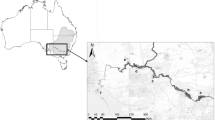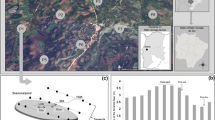Abstract
Seeds have morphoanatomical characteristics that determine the survival of plants in different environments, and these are directly related to phenomena such as dormancy. Natural selection filters the plant communities that inhabit the different ecosystems of planet earth and their seed banks. This has direct implications for ecological restoration. However, the seeds of aquatic plants have historically received much less attention than those of terrestrial ecosystems; and there is no history of morphoanatomical studies of seeds of aquatic vegetation for the Andes. In this research we studied the morphoanatomy of representative species of seed banks (SB), and floristic compositions of four Andean wetlands in a region with very high anthropic pressure such as the highland of eastern Antioquia. Results suggested that species with the highest abundances in the SB had seeds with morphophysiological dormancy and some had developed seeds with combined dormancy. The SB were dominated by mostly native aquatic plant species and emergent life forms that play an important role in the natural regeneration of these ecosystems. This study, in addition to being a pioneer in the investigation of the seeds of aquatic plants of the Andes, constitutes a guide for future studies for the design of ecological rehabilitation in wetlands that are under strong anthropic pressure.





Similar content being viewed by others
Data Availability
The datasets generated during and/or analyzed during the current study are available from the corresponding author on reasonable request.
References
Alzate F, Gómez M, Rodríguez S (2008) Especies vegetales del altiplano del oriente antioqueño en peligro de extinción, 1st edn. Lealon, Medellín
Angeler DG, García G (2005) Using emergence from soil propagule banks as indicators of ecological integrity in wetlands: advantages and limitations. 24:740–752. https://doi.org/10.1899/05-025.1
Arber A (1920) Water plants. Cambridge University Press, London
Baskin JM, Baskin CC (1989) Physiology of Dormancy and Germination in relation to seed Bank Ecology. In: Leck MA, Parker VT, Simpson RL (eds) Ecology of Soil seed banks. ACADEMIC PRESS, INC., New York, U.S.A, pp 53–66
Baskin CC, Baskin JM (2014) Seeds. Ecology, Biogeography, and Evolution of Dormancy and Germination, 2nd edn. doi: https://doi.org/10.1016/C2013-0-00597-X
Bernal R, Gradstein S, Celis M (eds) (2019) Catálogo de plantas y líquenes de Colombia. Instituto de Ciencias Naturales, Universidad Nacional de Colombia, Bogotá, D.C
Bigwood DW, Inouye DW (1988) Spatial pattern analysis of seed banks: an Improved Method and Optimized Sampling. Ecology 69:497–507. https://doi.org/10.2307/1940448
Chao A, Chiu C-H, Hsieh TC (2012) Proposing a resolution to debates on diversity partitioning. Ecology 93:2037–2051. https://doi.org/10.1890/11-1817.1
Corner EJH (1976) The seeds of dicotyledons. Cambridge University Press, New York, U.S.A
Courtney BYAD (2015) Seed Dormancy and Field Emergence Polygonum aviculare. J Appl Ecol 5:675–684
Cronk JM, Fennessy MS (2001) Wetland plants Biology and Ecology. Lewis Publishers, Florida
Dgebuadze YY, Gladyshev MI (2016) Biotic fluxes of matter and energy between aquatic and terrestrial ecosystems. Contemp Probl Ecol 9:391–395. https://doi.org/10.1134/S1995425516040041
Eckert CG, Dorken ME, Barrett SC (2016) Ecological and evolutionary consequences of sexual and clonal reproduction in aquatic plants. Aquat Bot 135:46–61. https://doi.org/10.1016/j.aquabot.2016.03.006
Garcia L, Koutchin-Reis L, Salis S et al (2021) Ecological restoration of Pantanal wetlands. In: Junior GA, Pott A (eds) Flora and Vegetation of the Pantanal Wetland, 1st edn. Springer Nature Switzerland, Cham, Switzerland, pp 739–761
Gleason HA (1917) The structure and development of the Plant Association. Bull Torrey Bot Club 44:481. https://doi.org/10.2307/2479596
González-Pinto A-L ESTRUCTURA, Y DIVERSIDAD FLORÍSTICA DE LA ZONA TERRESTRE DE UN, HUMEDAL URBANO EN BOGOTÁ (COLOMBIA) (2017). Rev. Luna Azul 45:201–226. doi: https://doi.org/10.17151/luaz.2017.45.11
Grace JB (1993) The adaptive significance of clonal reproduction in angiosperms: an aquatic perspective. Aquat Bot 44:159–180. https://doi.org/10.1016/0304-3770(93)90070-D
Hammer Ø, Harper DAT, Ryan PD (2001) Paleontological statistics software package for education and data analysis. Palaeontol Electron 4:9pp
Holdridge LR (1967) Life zone ecology. Trop Sci Cent doi: Via. https://doi.org/10.1046/j.1365-2699.1999.00329.x
Hong J, Liu S, Shi G, Zhang Y (2012) Soil seed bank techniques for restoring wetland vegetation diversity in Yeyahu Wetland. Beijing Ecol Eng 42:192–202. https://doi.org/10.1016/j.ecoleng.2012.01.004
Hopfensperger KN (2007) A review of similarity between seed bank and standing vegetation across ecosystems. Oikos 116:1438–1448. https://doi.org/10.1111/J.0030-1299.2007.15818.X
Hsieh TC, Ma KH, Chao A (2016) iNEXT: an R package for rarefaction and extrapolation of species diversity (Hill numbers). Methods Ecol Evol 7:1451–1456. https://doi.org/10.1111/2041-210X.12613
Imanishi A, Imanishi J (2014) Seed dormancy and germination traits of an endangered aquatic plant species. Euryale ferox Salisb (Nymphaeaceae) Aquat Bot 119:80–83. https://doi.org/10.1016/j.aquabot.2014.08.001
Johansen DA (1940) Plant Microtechnique, 1st edn. MeGraw-Hill Book Company, New York, U.S.A
Johri B, Ambegaokar K, Srivastava P (1992) Comparative embryology of Angiosperms. Doi: 10.1007 /978-3-642-76395-3
Junk WJ, Piedade MT, Wittmann F et al (2011) Amazonian Floodplain Forests: Ecophysiology, Biodiversity and Sustainable Management, 1st edn. doi: https://doi.org/10.1007/978-90-481-8725-6
Kaplan Z, Šumberová K, Formanová I, Ducháček M (2014) Re-establishment of an extinct population of the endangered aquatic plant Potamogeton coloratus. Aquat Bot 119:91–99. https://doi.org/10.1016/J.AQUABOT.2014.08.005
Lafontaine R, Beudels-Jamar R, Delsinne T, Robert H (2013) Risk analysis of theParrotfeather Myriophyllum aquaticum (Vell.) Verdc.
Lasso C, Morales-Betancourt M, Morales-B D (2014) Uso de la biota acuática en la identificación, caracterización y establecimiento de límites en humedales interiores. In: Lasso C, Gutiérrez F, de P, Morales-B D (eds) Humedales interiores de Colomba: identificación, caracterización y establecimiento de límites según criterios biológicos y ecológicos. nvestigación de Recursos Biológicos Alexander vonHumboldt (IAvH), Bogotá, D.C, pp 89–173
Liu H, Liu G, Xing W (2021) Functional traits of submerged macrophytes in eutrophic shallow lakes affect their ecological functions. Sci Total Environ 760:143332. https://doi.org/10.1016/J.SCITOTENV.2020.143332
MacArthur RH (1957) ON THE RELATIVE ABUNDANCE OF BIRD SPECIES. PNAS 43:295. https://doi.org/10.1073/PNAS.43.3.293
Marloth R (1883) über mechanische Schutzmittel der Samen gegen schädliche Einflüsse von aufsen. Botanische Jahrbücher für Systematik. Pflanzengeschichte und Pflanzengeographie 4:225–265
Martin A (1946) The comparative internal morphology of seeds. Univ Notre Dame 36:513–660. https://doi.org/10.2307/2421457
Martínez-Peña M, Díaz-Espinosa A, Vargas O (2012) Protocolo de Propagación de Plantas Hidrófilas y Manejo de Viveros para la Rehabilitación Ecológica de los Parques Ecológicos Distritales de Humedal. Grupo de Restauración Ecológica de la Universidad Nacional de Colombia y Secretaría Distrital de Ambiente, Bogotá, D.C
Mitsch WJ, Bernal B, Hernandez ME (2015) Ecosystem services of wetlands. Int J Biodivers Sci Ecosyst Serv Manag 11:1–4. https://doi.org/10.1080/21513732.2015.1006250
Montenegro -SAL, Ávila Parra YA, Mendivelso-CH HA, Vargas O (2006) Potencial de los bancos de semillas en la regeneración de la vegetación dell humedal Jaboque. Bogotá Colombia Caldasia 28:285–306
Osunkoya OO, Ali S, Nguyen T et al (2014) Soil seed bank dynamics in response to an extreme flood event in a riparian habitat. Ecol Res 29:1115–1129. https://doi.org/10.1007/S11284-014-1198-2/METRICS
Pineda-Gómez HD, Pimienta-Betancur A (2021) Recortes espaciales que configuran el Oriente antioqueño: de la región a la superposición de territorialidades. Territorios 1–22. doi: https://doi.org/10.12804/revistas.urosario.edu.co/territorios/a.9946
Raffaele E (1996) Relationship between seed and spore banks and vegetation of a mountain flood meadow (Mallín) in Patagonia, Argentina. Wetlands 16:1–9. https://doi.org/10.1007/BF03160640/METRICS
Ramos-Montaño C, Cárdenas-Avella NM, Herrera-Martínez Y (2013) Caracterización de la comunidad de Macrófitas acuáticas en lagunas del Páramo de la rusia (Boyacá-Colombia). Revista Ciencia en Desarrollo 4:73–82
Rial A (2014) Diversity, bioforms and abundance of aquatic plants in a wetland of the Orinoco floodplains, Venezuela. Biota Colomb 15:1–9
Saatkamp A, Cochrane A, Commander L et al (2019) A research agenda for seed-trait functional ecology. New Phytol 221:1764–1775. https://doi.org/10.1111/nph.15502
Salazar-Suaza D, Quijano-Abril MA (2020) Análisis multitemporal y caracterización de la vegetación hidrófita y helófita de un cinturón de humedales urbanos en el altiplano del oriente antioqueño. Rev Acad Colomb Cienc Exactas Fis Nat 44:639–651. https://doi.org/10.18257/raccefyn.1060
Sautu A, Baskin JM, Baskin CC, Condit R (2006) Studies on the seed biology of 100 native species of trees in a seasonal moist tropical forest, Panama, Central America. For Ecol Manag 234:245–263. https://doi.org/10.1016/j.foreco.2006.07.006
Sculthorpe CD (1967) The Biology of aquatic vascular plants. Edward Arnold Ltd, London
Smith SM, McCormick PV, Leeds JA, Garrett PB (2002) Constraints of seed bank species composition and water depth for restoring vegetation in the Florida everglades, U.S.A. Restor. Ecol 10:138–145. https://doi.org/10.1046/j.1526-100X.2002.10115.x
Smyth GK (2006) Nonlinear regression. Encyclopedia of Environmetrics. https://doi.org/10.1002/9780470057339.VAN017
Stearn WT (1983) Botanical Latin: history, Grammar, Syntax, Terminology and Vocabulary, 3rd edn. David and Charles Inc, United States
Thomaz SM (2021) Ecosystem services provided by freshwater macrophytes. Hydrobiologia 1–21. doi: https://doi.org/10.1007/S10750-021-04739-Y
Thompson K (2000) The functional ecology of seed banks. In: Fenner M (ed) Seeds: the ecology of regeneration in plant communities, 2nd edn. CABI Publishing, Wallingford, UK, pp 215–237
Tolivia D, Tolivia J (1987) Fasga: a new polychromatic method for simultaneous and differential staining of plant tissues. J Microsc 148:113–117. https://doi.org/10.1111/j.1365-2818.1987.tb02859.x
van der Hammen T, Gary-Stiles F, Rosselli L et al (2008) Protocolo de recuperación y rehabilitación ecológica de humedales en centros urbanos. Secretaría Distrital de Ambiente, Bogotá, D.C
van der Valk AG, Davis CB (1978) The role of seed banks in the Vegetation Dynamics of Prairie glacial marshes. Ecology 59:322–335. https://doi.org/10.2307/1936377
Van Drunen WE, Dorken ME (2012) Trade-offs between clonal and sexual reproduction in Sagittaria latifolia (Alismataceae) scale up to affect the fitness of entire clones. New Phytol 196:606–616. https://doi.org/10.1111/J.1469-8137.2012.04260.X
Whittaker RH (1960) Vegetation of the Siskiyou Mountains, Oregon and California. Ecol Monogr 30:279–338. https://doi.org/10.2307/1943563
Willis CG, Baskin CC, Baskin JM et al (2014) The evolution of seed dormancy: environmental cues, evolutionary hubs, and diversification of the seed plants. New Phytol 203:300–309. https://doi.org/10.1111/nph.12782
Xiong W, Zhu S, Zhu J et al (2021) Distribution and impacts of invasive parrot’s feather (Myriophyllum aquaticum) in China. Bioinvasions Rec 10:796–804. https://doi.org/10.3391/bir.2021.10.4.04
Acknowledgements
The authors especially thank the administrators of research and development of the Universidad Católica de Oriente for providing financial support for carrying out this research and the herbarium of the Universidad Católica de Oriente (HUCO).
Funding
This work was supported by the Research and Development Department of the Universidad Católica de Oriente, Rionegro, Antioquia, Colombia.
Author information
Authors and Affiliations
Contributions
Jose Miguel Rojas - Villa and Daniela Cardona Alzate conceived ideas. Daniela Salazar - Suaza, Daniela Cardona Alzate and Jose Miguel Rojas - Villa designed the field experiment and performed the field work, lab work and data analysis. Carlos Eduardo Sánchez Giraldo and Daniela Cardona Alzate performed the modelling work. Daniela Cardona Alzate and Mario Alberto Quijano - Abril supervised the project. All authors wrote the article.
Corresponding author
Ethics declarations
Competing Interest
The authors declare that they have no known competing financial interests or personal relationships that could appear to influence the work reported in this paper.
Additional information
Publisher’s Note
Springer Nature remains neutral with regard to jurisdictional claims in published maps and institutional affiliations.
Electronic Supplementary Material
Below is the link to the electronic supplementary material.
Electronic Supplementary Material
Below is the link to the electronic supplementary material.
Electronic Supplementary Material
Below is the link to the electronic supplementary material.
Rights and permissions
Springer Nature or its licensor (e.g. a society or other partner) holds exclusive rights to this article under a publishing agreement with the author(s) or other rightsholder(s); author self-archiving of the accepted manuscript version of this article is solely governed by the terms of such publishing agreement and applicable law.
About this article
Cite this article
Alzate, D.C., Quijano-Abril, M.A., Salazar-Suaza, D. et al. Morphoanatomical Analysis and Diversity of Andean Urban Wetland seed Banks: A tool for Ecological Rehabilitation. Wetlands 43, 67 (2023). https://doi.org/10.1007/s13157-023-01715-1
Received:
Accepted:
Published:
DOI: https://doi.org/10.1007/s13157-023-01715-1




